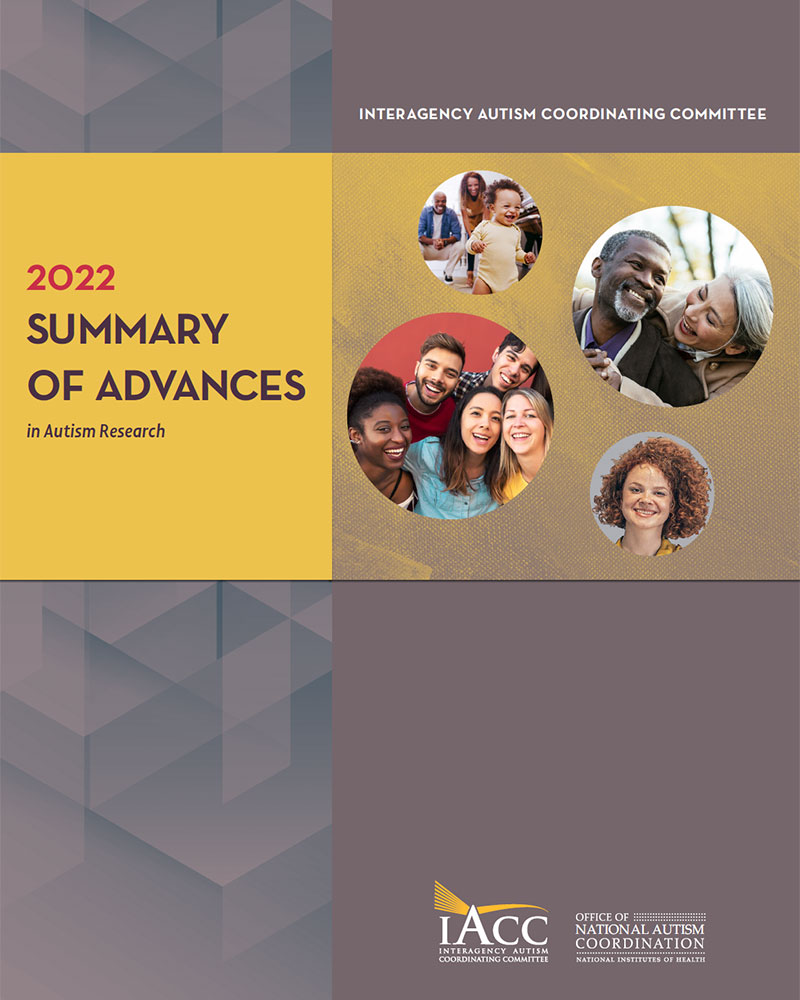Summary of Advances
In Autism Research
2022
Disparities in Early Intervention Program Participation by Children With Autism Spectrum Disorder in a US Metropolitan Area, 2006 to 2016.
Shenouda J, Barrett E, Davidow AL, Sidwell K, Halperin W, Silenzio VMB, Zahorodny W. JAMA Pediatr. 2022 Sep 1;176(9):906-914. [PMID: 35849409]
At-a-Glance
Less than half of the children in New Jersey diagnosed with autism between 2006 and 2016 received early intervention services, and significant socioeconomic and racial/ethnic disparities were observed, underscoring the urgency to address disparities and increase access to early intervention.
Background: Signs of autism may be observable by 18 months, and ASD can be reliably diagnosed by 24 months. Research has shown that earlier receipt of services and supports is associated with better outcomes for children diagnosed with ASD. In the United States, Part C of the Individuals with Disabilities Education Act (IDEA) guarantees infants and toddlers with developmental delays and disabilities access to Early Intervention Programs (EIPs). This study investigated the extent to which children diagnosed with ASD accessed EIP services between 2006 and 2016 across four New Jersey counties and whether access was influenced by certain sociodemographic factors.
Methods & Findings: Researchers analyzed special education and medical records collected from multiple cohorts of 8-year-old children included in the New Jersey Autism Study, a part of the Autism and Developmental Disabilities Monitoring (ADDM) Network, between 2006 and 2016. A total of 4,050 children with ASD were identified across cohorts, of whom 46.6% received EIP services. Receipt of these services increased from 39.3% in the 2006 cohort to 55.5% in the 2016 cohort and varied based on socioeconomic status, race, level of disability, and age of developmental delay diagnosis. Among White children with autism, 49.1% received EIP services versus 45.2% of Hispanic and 43.3% of Black children with autism. Further, 49.0% and 53.1% of children living in census regions associated with middle and high socioeconomic status, respectively, received early intervention services, versus only 41.7% of children living in low socioeconomic status regions. Among children classified by expert clinicians as having significant disability, 57.3% received early intervention services versus 40.1 to 46.6% of children with less significant disability. Furthermore, statistical modeling showed that children who were diagnosed with a developmental delay before 36 months of age were 2.64 times as likely to receive early intervention services if born in 2008 versus 1998.
Implications: Although the use of early intervention services is on the rise, this study demonstrates that a significant proportion of children with autism still are not receiving these services. Furthermore, race and socioeconomic-based disparities in the receipt of early intervention services persist. Future research should further investigate these disparities to improve early intervention access and outcomes for all children diagnosed with autism.
Mental health screening in pediatric primary care for children with autism.
Stadnick NA, Martinez K, Coleman KJ, Gizzo DP, Lane E, Lee N, Kuelbs CL, Aarons GA, Brookman-Frazee L. Autism. 2022 Jul;26(5):1305-1311. [PMID: 35105226]
At-a-Glance
Pediatricians can identify early mental health concerns in school-age children with autism through screening during well-child appointments, and opportunities exist to refine screening and linkage efforts across pediatric care settings.
Background: Children with autism experience high rates of co-occurring mental health needs. Many of these conditions require long-term interventions, and earlier detection may lead to better mental health outcomes. As primary points of contact for children’s healthcare, pediatricians are well positioned to identify children’s mental health needs early and connect them to necessary mental health services. This study evaluated the use and impact of mental health screening in pediatric primary care clinics for children with autism.
Methods & Findings: Researchers analyzed demographic and mental health screening data from 166 children with autism, aged 4 to 16 years, who attended well-child appointments at one of two Southern California healthcare systems. Across both organizations, study patients were 8 to 9 years old on average, predominantly male, and approximately half identified as Hispanic/Latino. Primary care providers screened patients for mental health concerns using the Pediatric Symptom Checklist-17 (PSC-17), a short questionnaire used by providers to identify psychosocial challenges in children. The screening rates at both organizations were similar (53% and 55%, respectively), and the rates at which children were identified as having potential co-occurring mental health concerns was high, ranging from 36 to 47%. Children who screened positive for potential mental health concerns tended to score highest on checklist items measuring attention challenges and challenging behaviors. Following their positive screen, 45 to 57% of these children were referred to mental health services by their primary care provider. Researchers observed no significant demographic differences in screening or referral rates.
Implications: The high rates of positive mental health screening reported in this study align with previous findings indicating high rates of co-occurring mental health needs in children with autism. Furthermore, given that slightly over half of the eligible patients received mental health screening, this study demonstrated the feasibility of mental health screening in pediatric primary care settings. However, because many eligible children were not screened and many who screened positive were not referred to mental health services, future studies should investigate how to increase screening rates and post-screening referrals, including optimal timing of mental health referrals, to improve engagement in needed mental health services.




